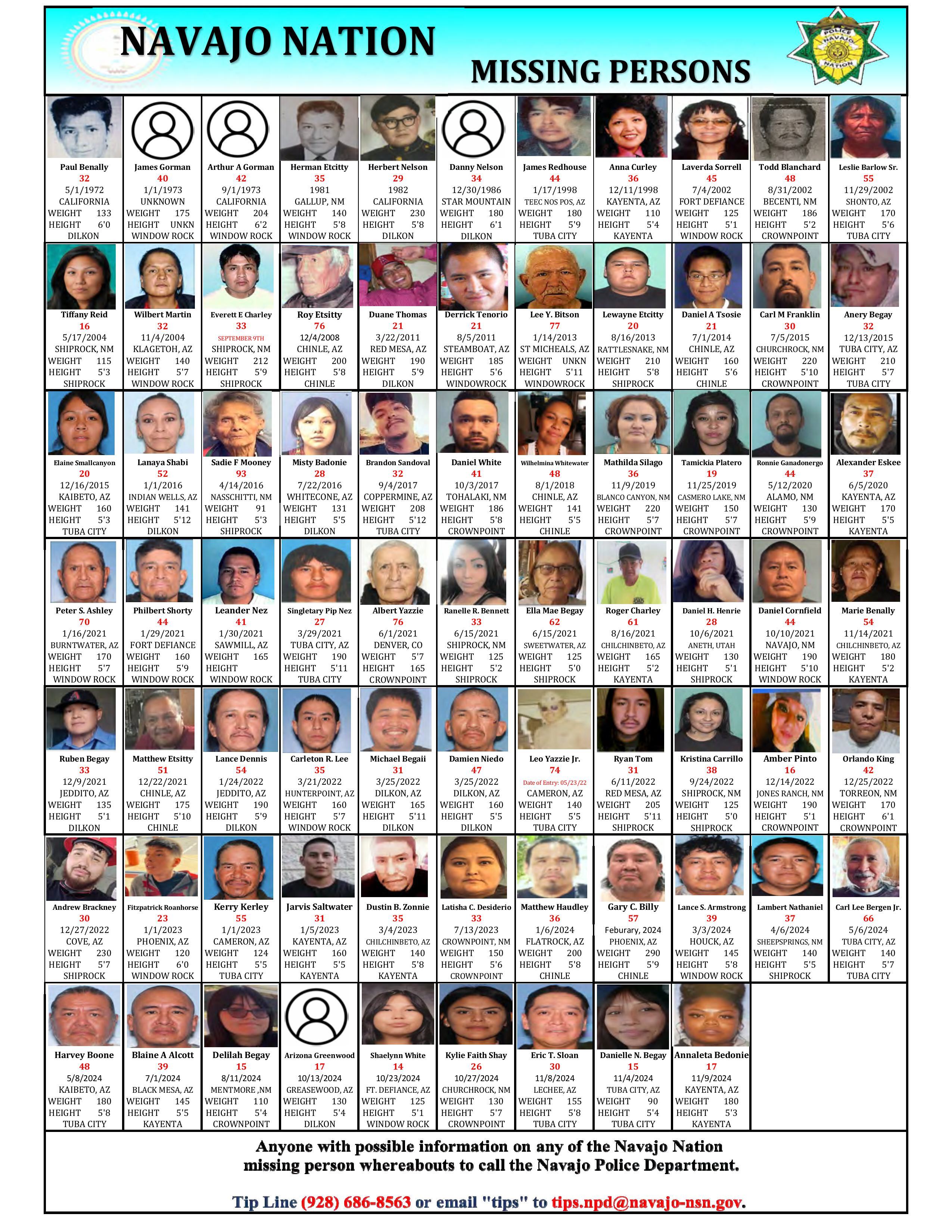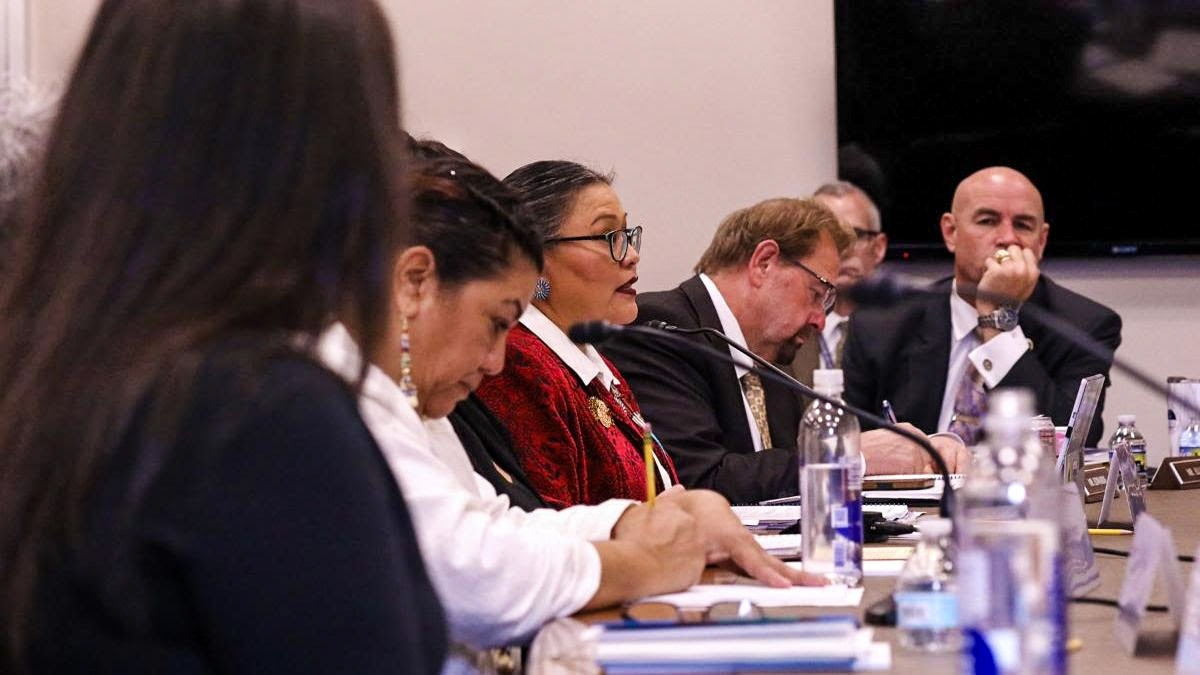WASHINGTON – Despite grants and numerous programs to help mitigate the issue, cases of missing or murdered Indigenous women continue at relatively high rates.
The extent of the problem is almost certainly underestimated.
The National Missing and Unidentified Persons System showed a dozen missing Indigenous women from Arizona as of mid-2020. They’d been missing, on average, for 21 years. But the Arizona-based Navajo Nation alone lists 22 missing women. Some of the cases date to the 1970s.
Advocates for women and Native American crime victims attribute the chronic undercounts and frustrations with resolving these cases to confusion over jurisdiction and lack of cooperation among law enforcement agencies.
“Sadly because a person is Navajo, it is sometimes assumed that Navajo will handle the case – in essence, the buck gets passed,” said Eugenia Charles-Newton, chair of the law and order committee of the Navajo Nation Council.
Indigenous women are five times more likely than white women to experience violence from their partners, according to research from the National Congress of American Indians.
Arizona has two tribal women’s coalitions that aid survivors of domestic and sexual violence. The Hopi-Tewa Women’s Coalition to End Abuse works with Hopi women. The Southwest Indigenous Women’s Coalition works with others.
“If we could have ended this violence against ourselves, we would have done it a long time ago,” said Memory Longchase, the domestic violence response director of Southwest Indigenous Women’s Coalition.
Jurisdiction issues occur in cities where tribal members live and on or near reservations.
A 2018 report from the Urban Indian Health Institute identified 153 cases of missing or murdered Indigenous women that do not exist in any law enforcement records. The report focused on 71 cities in 29 states, including Phoenix, Tucson, Tempe and Flagstaff.
Abigail Echo-Hawk, director of the Urban Indian Health Institute and a member of the Pawnee Nation in Oklahoma, said city police departments often assume that if a tribal member reports a crime, it is the tribe’s responsibility to handle the case – even if the woman doesn’t live on tribal land.
That misconception has caused a “nationwide data crisis” that hides the extent of violence involving Indigenous women and girls, according to the report. It also causes investigative delays or leads to cases slipping through the cracks entirely.
And that, advocates say, has discouraged people from even reporting such cases, out of a common belief that “if somebody … goes missing … they’re probably not going to do anything,” Longchase said.
Tucson ranked fourth on the list of cities in Echo-Hawk’s report. Arizona had the third most cases of missing or murdered Indigenous women and girls cases.

In Arizona, 10 of the 12 women listed in the National Missing and Unidentified Persons System had lived in rural areas, according to an Arizona State University research study. Their ages ranged from 20 to 54.
The Department of Justice started the Missing or Murdered Indigenous Persons (MMIP) Regional Outreach Program in mid-2023 to help with jurisdictional issues.
Five regional programs are each assigned an assistant U.S. attorney and a program coordinator. The Southwest program encompasses Colorado, New Mexico, Utah, Arizona and Nevada.
The program is intended to streamline communication between tribes and state governments. It is still in its early stages.
In 2023, 10,650 missing persons cases were filed for American Indians and Alaskan Natives, according to the FBI. By the end of the year, 1,631 remained open; about 40% of those involved women.
But advocates say many that Native American women have learned through hard experience that abusers rarely face prosecution, so some don’t ask authorities for help.
“If you know five people that have been raped and reported it and nothing happened, how likely are you to report?” Longchase said.
Jurisdiction issues can be complicated in Indian Country. Policing and prosecution is split between tribes, counties and the state and federal governments. The responsible entity in many cases is unclear.
“No one has been willing to take up the cause to say all law enforcement regardless of where they reside are responsible for the public safety of everybody in their communities, and that absolutely includes the first people of this land,” Echo-Hawk said.

Charles-Newton said she was a victim both of violence and a lack of follow-up by authorities. When she was 17, her abuser took her to a shack for about a week. She didn’t know where she was, though she knew the abuser.
“Because I didn’t know where I was being kept – where the shed was located – they could never identify the jurisdiction,” she said. “And the man – who I knew – … I said his name – they never prosecuted him.”
Native women and men both experience high rates of victimization, with 84% of women and 82% of men reporting they had experienced violence at some point, according to DOJ data.
More than half of Native women have experienced sexual violence, according to the National Institute of Justice – far higher than the overall rate of one in six. Native women are twice as likely to experience sexual assault compared to other races, according to the Rape, Abuse, and Incest National Network.
A House Appropriations subcommittee held a hearing on November 20 on what it called the Crisis of Missing or Murdered Indigenous Women.
Five witnesses, all advocates for missing and murdered Indigenous women, each told the panel they knew at least one missing person. Each also had been a victim of violence.
“This is obviously a vitally important issue to all of us,” the subcommittee chairman Rep. Mike Simpson, R-Idaho, said. “It brings up many questions and only some of them (involve) funding.”
Multiple laws and programs have been implemented in recent years to alleviate jurisdiction and communication issues. The witnesses said frustrations persist.
“The jurisdictional issues have really just become an excuse, an excuse to not do the job,” Charles-Newton testified.
Congress approved the Not Invisible Act in 2020 and established a joint commission between the DOJ and the Department of the Interior to reduce violent crimes against Native Americans. The act established a cross-jurisdictional advisory committee of tribal leaders, federal officials and relatives of missing and murdered individuals.
Another 2020 measure known as Savanna’s Act – named for Savanna LaFontaine-Greywind, a member of the Spirit Lake Nation who was murdered when she was eight months pregnant – was meant to streamline communication between state, federal and tribal governments and improve MMIP data collection.
The Violence Against Women Act also provided $86 million for the DOJ to help tribal victims and support programs.
“This is way out of proportion to what happens in other areas,” said Rep. Tom Cole, R-Oklahoma, chairman of the Appropriations Committee and member of the Chickasaw Nation. “We clearly have a very unique problem. We clearly have a lack of jurisdiction in many cases. … We clearly have an enormous resource problem.”
For more stories from Cronkite News, visit cronkitenews.azpbs.org.Note: This story originally appeared on Cronkite News. It is published via a Creative Commons license. Cronkite News is produced by the Walter Cronkite School of Journalism and Mass Communication at Arizona State University.
AUDIO: Sea Lion Predation in the Pacific Northwest
Native America Calling: Tribal colleges see an uncertain federal funding road ahead
Native America Calling: Short films taking on big stories
Native America Calling: Advocates push back against new obstacles to Missing and Murdered Indigenous Relatives momentum
Native America Calling: For all its promise, AI is a potential threat to culture
NAFOA: 5 Things You Need to Know this Week (November 24, 2025)
Chuck Hoskin: Cherokee Nation invests in rural transportation
Native America Calling: Native candidates make strides in local elections
National Congress of American Indians returns incumbents and welcomes newcomers to leadership
National Congress of American Indians chooses leadership at big convention
‘Not voting is still a vote’: Native turnout drops amid changes in political winds
Native America Calling: Indigenous voices speak up, but have little clout at COP30
‘It’s bull****’: Indian Country confronts challenges at largest inter-tribal conference
Native America Calling: The constant burden on tribal hunters to justify their treaty rights
More Headlines